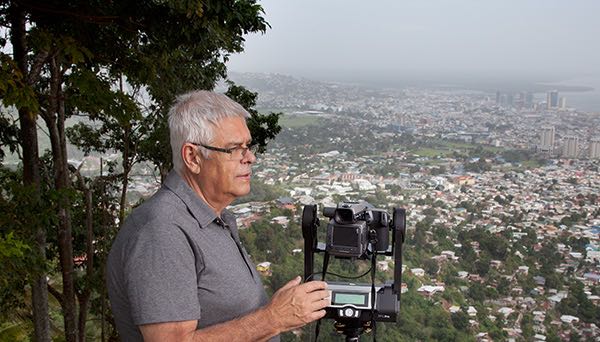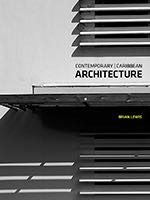The architect as photographer
25/11/15 15:03 Filed in: Profile

Brian Lewis, photographed at Fort George. Photo by Mark Lyndersay.
One of two forewords written for the publication of Brian Lewis' collection of photographs examining Contemporary Caribbean Architecture, published in November 2015.
It’s probably worth stating this right up front for anyone who has somehow missed the fact, but Brian Lewis, the author of this body of work, is a second generation architect.
Indeed, he is a fine designer of buildings, many of which are remarkable examples of Caribbean habitat, so it might not be out of line to wonder why he would bother to be down in the scrum of taking photographs.
At least part of the reason would surely be a desire to have good photographs of his work. I can empathise.
Many years ago, I despaired of the photographs that accompanied my stories in the daily newspapers and began taking my own.
That can be a powerful motivator, the need to fully realise a vision, and for a man capable of imagining completed structures where there are only stakes in the mud demarcating land boundaries, the desire must be overwhelming to shepherd a building from imagination to two dimensional plans and into constructed reality.
To have that process scuttled in the public mind by lousy photos of a carefully designed building is to drop the baton before the race is done.
That might explain why Brian took up a camera. To understand why he continued and amplified his goals into this epic effort at capturing the designs of others is, ultimately, the thesis of this book.
The architect, you see, is not just a vendor, he’s also the client.
Brian Lewis loves a well-designed building. Actually, he loves a well-designed anything, but his passion for structures is lush and promiscuous.
He may frown at a detail or two he might have approached another way, but he is fully capable of basking in the clarity of vision of another architect’s sensibility and that informs his images with a passion that’s rare in the business of architectural photography.
This all began in his teens, but truly flowered when he began photographing the buildings his architectural firm was producing.
By the time I met Brian he was firmly placed in my mind as an exceptional architectural photographer with a little side practice in designing buildings.
It was on that basis that I asked him to offer some photographs for publication in the Trinidad and Tobago Guardian’s Sunday magazine, then rather pointedly named SG Magazine.
He responded by offering, pretty much once a month, a remarkable selection of images for which we never had enough space.
His writing accompanying these stories was clear and sensible but the photographs immersed you in the architect’s thinking and more impressively, made it clear why Brian thought the design work was worth a potentially disinterested party’s attention.
For as long as the magazine was published under my guidance, roughly a year and a half, Brian regularly delivered a selection of remarkable images, evolving his approach to compensate for the stark and brutish treatment they received on newsprint and always sticking to a clear and lucid style that guided and informed.
In remembering that work, and reviewing what Brian has produced for Contemporary Caribbean Architecture, I’d be tempted to call that early work Lewis Lite if it weren’t more accurate to think of it as a rehearsal for the far richer palette he has developed for reproduction here.
His earlier ascetic style has matured into a deeper appreciation for all the variations of light, texture and personal quirkiness that characterise our most successful architecture.
Brian is unafraid of that most challenging of subjects, the Caribbean building lit by the stark, cold light of midday sun, and he uses that cruel severity in many photos to bring deep drama to rooms designed to be illuminated by dark patterned shadows.
The minimalist sharpness of these buildings leap to life as frames that embrace the bold colours of the landscape, the rich blues of sky and sea, the brilliantly verdant vegetation and the languid browns of the wood that accent them.
The enormity of the work is staggering. I dabble a bit in architectural photography myself, but really, what I do is take attractive portraits of buildings.
Brian digs in deep, feeling the foundations of the buildings, understanding the arc of the walls and the dip of the stairwells.
It’s possible to do this work in a day or two, but that supposes a perfect 48 hours and that’s a fantasy that anyone who has waited out a building will find utterly hilarious.
This is work that demands an understanding of line and form, of textures and shapes, of light and shadow. It begins with photography, with all its optical and dynamic range challenges, but can only be brought to a successful conclusion through a profound empathy with the architect’s intent and an understanding of the building as a designed space.
The successful architectural photographer does not simply photograph a building, he inhabits it visually, bringing the designer’s concept, the contractor’s concrete, metal, wood and glass and the style of the owners and their impact on the space together into still frames, collections of pixels and dots of ink on paper that breathe a new life and understanding into the finished project.
So the work that follows is the result of Brian’s stalking of these buildings, his wooing them with a careful study of how the light plays over their forms before he chooses his firm and definitive interpretation of the structure.
These are works of both cool contemplation and considerable passion, the frames of Brian’s images taut with consideration and very deliberate points of view.
He leads us through these buildings with a confident awareness of their purpose and their considerable pleasures.
Brian Lewis has always brought a distinct and clear perspective to his architectural photography. I can always identify his work, no matter where it appears.
That’s a special talent.
To be able to clearly and professionally represent the collaborative work that is a lived space is rare enough. To be able to do so while stamping the work with a distinctive style makes the final project transcendent.
I commend to you with professional pride and personal envy the work of Brian Lewis on the following pages. His loving, precise rendition of the work of the many architects, artisans, contractors, interior designers and commissioning clients speaks eloquently for itself.
blog comments powered by Disqus
